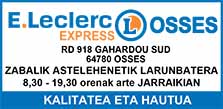Haley Harrison. Iñaki Arrieta Baro remembers the day he trekked through the sagebrush, desert and wooded trails of Northern Nevada with a Basque-American family to locate a very special ancestral heirloom. Tracing their grandfather's footsteps, the group followed GPS coordinates to a remote location on what is now a private ranch.
Among a grove of aspens, they found what they were looking for: a tree engraved decades ago with their grandfather's name.
"We were standing in the same place where their grandfather stood," says Arrieta Baro, head librarian of the Jon Bilbao Basque Library at the University of Nevada, Reno. "It was very emotional."
Between the US Pacific coast and the state of Wyoming, stories from the region's 19th and 20th-Century Basque immigrant sheepherders unfold across the malleable bark of quaking aspen trees, turning rugged alpine forests into history books. From names and cartoon images to hometown homages and political messages etched in Euskara, Europe's oldest living language, these arborglyphs – tree carvings – offer a quiet glimpse into these often forgotten lives.
"The arborglyphs are a lens through which to understand the Basque immigrant community and sheepherding," says Arrieta Baro.
Carefully placing a piece of tree trunk in front of me, he directs my attention to its inscription: "Jesús María El Cano, 26-7."
El Cano was one of many Basque men who found themselves at the helm of sheep flocks in the American West. Initially drawn to the Great Basin region across California, Nevada and Idaho in the wake of the 19th-Century gold rush, Basques continued to migrate through the next century in search of better economic prospects.
Amaya Herrera, curator at the Basque Museum and Cultural Center and one of an estimated 16,000 Basque-Americans living in Boise, Idaho, descends from one such family. "My great-grandparents immigrated in the late 1890s. They worked in ranching and then later ran a boarding house in Northern Nevada," she says, "That's how my family ended up there."
Boarding houses like the one managed by Herrera's great-grandparents were the infrastructural beginnings of Basque communities in the West, such as Boise's Basque Block. They provided not just lodging, but a place to connect with other Basques and, very importantly, find employment.
Though the newly-arrived Basques had no previous experience with large-scale herding, they adopted the vocation out of necessity – primarily because they spoke little to no English.
Sheepherding didn't require much speaking at all.
"They spent a lot of time in the mountains by themselves," says Arrieta Baro, referring to the transhumance herding technique that saw sheepherders move flocks up to the mountains to graze during the spring and summer and back down to the valleys for the colder seasons. These long stints of isolation were as unfamiliar to the Basques as the landscape.
Far from their families and homeland, the sheepherders turned to the trees in their solitude, whittling messages and illustrations to communicate "their inner selves, their emotions, how much they miss gure ama", Arrieta Baro explains, adding that gure amameans "our mother" in Euskara.



 Lagun bati bidali
Lagun bati bidali Komentarioa gehitu
Komentarioa gehitu








